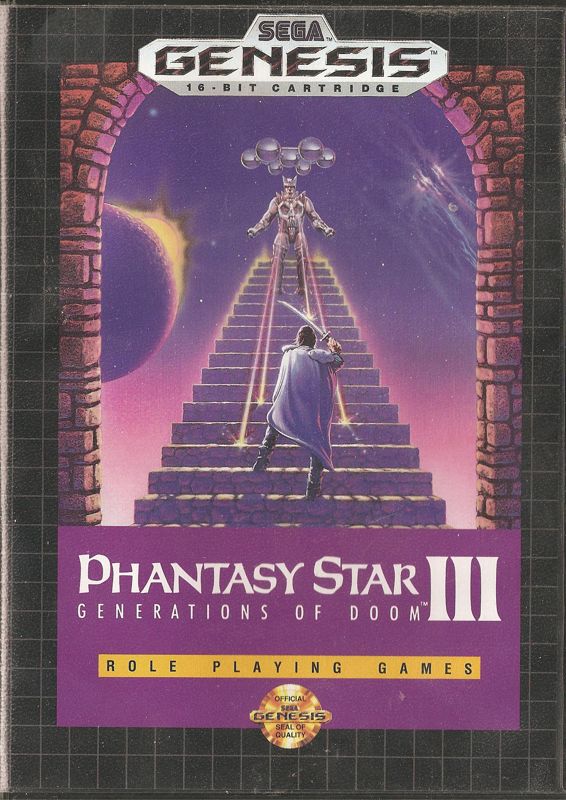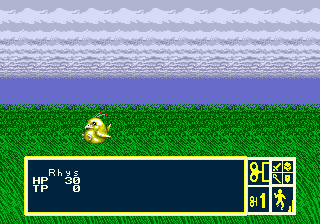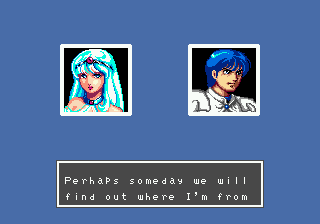Retro Replay Review
Gameplay
Phantasy Star III: Generations of Doom retains the classic top-down overworld exploration and turn-based combat that fans of the series have come to love. You guide a party of characters across a medieval-inspired landscape, entering towns to interact with NPCs, rest at inns, and purchase supplies. Dungeons are presented in a straightforward 2D style, with random enemy encounters triggering tactical battles on a separate battle screen. This familiar structure makes it easy for series veterans to jump back in while remaining accessible to newcomers.
(HEY YOU!! We hope you enjoy! We try not to run ads. So basically, this is a very expensive hobby running this site. Please consider joining us for updates, forums, and more. Network w/ us to make some cash or friends while retro gaming, and you can win some free retro games for posting. Okay, carry on 👍)
What truly sets this installment apart is its innovative generational system. After key story moments, you choose who Rhys, the first protagonist, will marry—Maya or one of two other candidates. This decision not only affects Rhys’s second-generation heir but also branches the narrative into distinct paths. A similar choice for the second generation expands the story into four possible lines. Each branch offers unique party members, techniques, and strategic options, encouraging multiple playthroughs to experience every storyline twist.
Combat itself remains a traditional menu-driven affair. Characters have access to physical attacks, defensive moves, items, and “Techniques”—magical or psionic abilities. Unlike its sci-fi predecessors, this game’s early generations lean heavily on swords and shields, forcing the player to rely on item management and clever tactics rather than flashy spells. Only later, when technologically advanced allies join your party, do high-powered Techniques come into play. This pacing reinforces the medieval setting while still offering that signature Phantasy Star flair.
Graphics
Released on the Sega Genesis, Phantasy Star III’s graphical style balances clarity with charm. The overworld map features bright, contrasting colors that make each terrain type—plains, forests, and deserts—distinct and easy to navigate. Character sprites are small but well-defined, with recognizable outfits and silhouettes that reflect their class or origin. Towns and dungeons each have their own visual palette, ensuring environments feel unique rather than repetitive.
While the title may lack the detailed animations of later 16-bit RPGs, its sprite-based artwork remains appealing. Battle animations for Techniques and special attacks add visual flair, with simple but effective effects like swirling magic circles or slashing swords. Enemy designs are varied, ranging from medieval goblins to remnant robotic foes from Phantasy Star’s sci-fi heritage. These creatures pop against the static battle backgrounds, keeping encounters lively and engaging.
Cutscenes between generational shifts use text and static images rather than elaborate cinematic sequences. Though modest by modern standards, these artwork interludes successfully convey emotional beats—Rhys’s shock at Maya’s kidnapping, the blossoming romance of his children, and the uncertainty of a world still healing from its ancient war. Fans of retro aesthetics will appreciate the clean lines and nostalgic charm, even if they’re accustomed to more polished visuals today.
Story
Phantasy Star III opens with the aftermath of a devastating war between the cosmic forces Orakio and Laya, leaving the planet in ruins. A millennium later, young Prince Rhys of Orak embarks on a journey to wed his beloved Maya. The ceremony is interrupted by a mysterious creature that spirals Rhys into a quest to rescue her. From the outset, the narrative hooks you with personal stakes—this is not just a battle for the world’s fate but a deeply intimate rescue mission.
The branching marriage mechanic shapes more than character names; it reshapes the entire saga. Depending on whom Rhys chooses, the next generation’s protagonist can be a knight, a scholar, or even a rogue, each with their motivations and relationships. These choices impact dialogue, party dynamics, and the ultimate confrontation with the unseen force behind Maya’s abduction. The story’s replay value is substantial—fans have uncovered new alliances and character arcs through successive playthroughs.
Throughout three generations of heroes, themes of legacy, love, and the remnants of ancient conflict weave together. The story explores how choices made by one generation affect the next, both in terms of lineage and the world’s political landscape. Though the writing occasionally leans into melodrama, it balances moments of heartfelt sincerity—Rhys’s unwavering devotion to Maya, the hopes of his children, and the legacy they inherit from their forebears.
Overall Experience
Phantasy Star III: Generations of Doom offers a unique blend of classic JRPG mechanics and an ambitious narrative structure. Its generational system remains one of the series’ most memorable innovations, rewarding players who invest the time to explore every branch of the family tree. While some may find the pacing slow during the game’s medieval opening chapters, the payoff of new Techniques, characters, and story paths makes persistence worthwhile.
The game’s audiovisual presentation, though modest by later 16-bit standards, exudes a nostalgic charm that complements its timeless themes. The lack of elaborate cutscenes is offset by well-crafted sprite work and evocative battle effects, creating an atmosphere that feels both familiar and distinctive. Fans seeking a deep, character-driven quest will find much to appreciate in its three-generation saga.
For RPG enthusiasts curious about the evolution of the genre, Phantasy Star III stands as a fascinating milestone. It bridges medieval fantasy and sci-fi both in setting and gameplay, offering a layered experience that rewards exploration and experimentation. Whether you’re revisiting it on original hardware or through one of its modern ports, Generations of Doom remains a compelling adventure well worth your time.
 Retro Replay Retro Replay gaming reviews, news, emulation, geek stuff and more!
Retro Replay Retro Replay gaming reviews, news, emulation, geek stuff and more!









Reviews
There are no reviews yet.